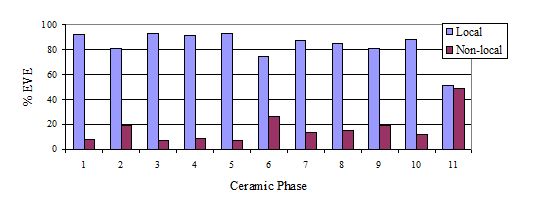
Cite this as: Compton, J. and Biddulph, E. 2015, Late Iron Age And Roman Pottery Synthesis, in M. Atkinson and S.J. Preston Heybridge: A Late Iron Age and Roman Settlement, Excavations at Elms Farm 1993-5, Internet Archaeology 40. http://dx.doi.org/10.11141/ia.40.1.compton6
The previous sections have explored the range and nature of the late Iron Age and Roman period pottery (i.e. the fabrics, key pottery groups, pottery supply, vessel functions and the amphora, mortarium, samian and kiln assemblages) retrieved from the excavations. It is thus now appropriate to consider the implications for the understanding of Heybridge in terms of its internal functioning and its relationship to the settlements around it. As regards the latter, the location of Heybridge, being roughly equidistant between Camulodunum/Colchester and Chelmsford, is particularly relevant.
Clearly, the assemblage is large, diverse and important, and the implications not only primarily concern Heybridge, but also have applications for the wider regional background and for pottery studies in general. The successes of this pottery study are many. Those which can be highlighted are the identification of pyre debris assemblages, the impact of local pottery production and the compilation of a late Iron Age typology. Much of the study has concentrated on non-local aspects of the pottery, perhaps to the detriment of the appreciation of the role played by localised production and supply.
Continuous occupation at Heybridge throughout the late Iron Age and Roman periods provides an excellent opportunity to test hypotheses relating to pottery supply to the settlement. In particular, the peaks and troughs encountered here can be viewed against a regional backdrop of perceived economic and social trends. For the late Iron Age, reference is made to Camulodunum (Hawkes and Hull 1947), although the settlement at Heybridge seems to have an earlier start date during the second half of the 1st century BC. Camulodunum was certainly established during the first decade of the 1st century AD, but probably no earlier. The settlements in the Puckeridge-Braughing area of Hertfordshire have much more relevance to Heybridge at this early date. For the Roman period, Chelmsford, naturally, is the first choice for comparison, along with Colchester, while Going's 'economic long waves' paper (1992b) provides a very useful reference point.

What is clearly evident is that Heybridge was always dependent on local suppliers, although, admittedly, late Iron Age pottery production per se is archaeologically undetectable. Locally-produced coarse wares dominated all assemblages in the late Iron Age and throughout the Roman period until the late 4th century AD (Figure 753). The late Iron Age imported wares found at Heybridge form a substantial proportion of the assemblage, but, even so, locally-made coarse pottery is overwhelmingly predominant, and the proportion never falls below 75% of the total until the late 4th century. Much of the pottery is plain and undecorated, and indeed, is characterised by its ordinary, utilitarian nature. While the kilns at Heybridge provide unequivocal evidence of local production, it is hardly likely that this production was limited only to the periods that the known kilns were in use, i.e. late 2nd to early 3rd, and late 3rd to early 4th centuries. That the patterns of Roman-period supply of Chelmsford and Heybridge do not match suggests that the two settlements were placed in two different, though sometimes overlapping, marketing zones, defined by geographical (roads, rivers, and coastal access) and, possibly, cultural, social and economic, boundaries. A number of factors support this view. Some vessel types were introduced to Heybridge later than at Chelmsford, while others were current for longer. The poppy-headed beaker is a good example of this. It was present at Chelmsford before AD125, but reached Heybridge after this date. The performance of certain fabrics diverged, also. For example, the surge of North Kentish products evident at Heybridge during the mid 2nd century went unmatched at Chelmsford. Common to both sites is the fact that Colchester colour-coated ware did not appear until after c. AD140/150, some fifteen years after the earliest forms were being made. This provides the best evidence that neither settlement was receiving the majority of their coarse wares from Colchester, but from more local sources. It is highly unlikely that supplies of pottery arriving from Colchester during the early 2nd century did not include any fine wares.
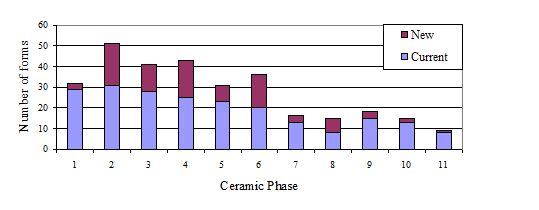
The performance of a predominantly local pottery industry gives some insight into the economic fortunes of the settlement. The ability of potters to develop new forms and expand their repertoires was, to some extent, dependent on the health of the market, with a high demand encouraging greater production. As a consequence, potters displayed diversity and inventiveness. Figure 754 presents an overview of the level of innovation through time. The late 1st century BC saw the beginnings of local potters copying imported platters and flagons, coupled with experimentation and the mastering of wheel-throwing techniques. This increased during the 1st century AD when a far larger array of pottery types was imported and, later in the century, production of Roman types became established. During the later 1st century local industries produced a large number of forms and introduced an almost equally high number of new types; a sign, perhaps, of high consumer demand and burgeoning markets. This was not restricted to Heybridge; Going identifies the later 1st century AD as a 'long' period for pottery production and one of economic prosperity (1992b, 98). This was immediately followed by a period of stability at Heybridge, though this was short-lived. The mid 2nd century heralded another phase of relative prosperity and market expansion. This is evident in the pottery reaching the settlement from outside sources. Colchester began to export in earnest, and importation from North Kent reached its highest level. This prosperity firmly places Heybridge within the general economic trend for the region, and demonstrates participation in, rather than active isolation from, Romanized market-based economics.
The contraction experienced by the local producers at the end of the late 2nd century continued without abatement to the end of the Roman period. This fits squarely with the evidence from the pottery kilns at Heybridge, which demonstrate limited repertoires. Mass production of pottery may have led to standardization of vessel forms and an increase in pottery available, resulting in a decrease in skills and thus stagnation. Production during the late Roman period must have barely risen above subsistence level. Potting seasons were short, demand was low, and potters were producing little more than the bare minimum of the basic types required. But, remarkably, until the late 4th century, the inhabitants at Heybridge were still using local pottery with no major disruption to distribution.
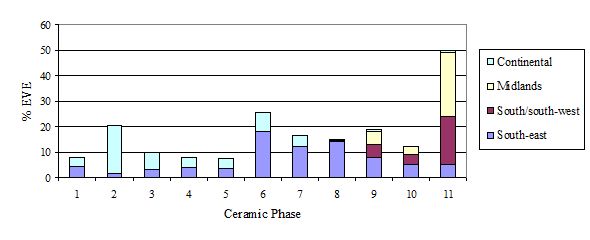
The late 3rd to early 4th centuries mark a clear division in terms of supply. At no time before the second half of the 4th century do the regional industries challenge the dominance of the local producers. Until the later 4th century the proportion of non-local pottery from the restricted range of sources barely exceeds 20%. Before this date, Heybridge was supplied almost exclusively with pottery from the south-east, particularly Colchester and Thameside/Kent, along with continental sources. It is interesting to note that the London and Verulamium industries provided only minor amounts of pottery, barely contributing more than 1% in any phase. Heybridge may well have been outside the catchment areas for these industries, but this also serves to remind us that the distribution of many industries, even the larger ones, was predominantly localised. Supply dwindled from these south-eastern sources towards the end of the 3rd century, perhaps after failing to re-focus on their home markets after the loss of lucrative military/frontier markets (Going 1987, 117). Continental supply, sustained at a low, but steady, level since the late Iron Age, also ceased during the 3rd century. But the Hadham and Nene Valley industries, supplemented by Dorset BB1, saw their opportunity and took it, dominating non-local supply until the late 4th century. Despite the diversification of sources, pottery supply to Heybridge up to this point was reasonably constant. This changed utterly in the late 4th century.
Determining when local production finally ceased at Heybridge is problematic. The pottery kiln in Area L was last fired during the first half of the 4th century AD. However, the presence of local wares in contexts dated to the late 4th century attests to continued production elsewhere. The latest-dated group (KPG39) has low amounts of local wares, suggesting, at the very least, markedly reduced production. Dating of this group is unclear. Since higher quantities of regional wares, particularly late shell-tempered and Oxfordshire red colour-coated wares, are more evident in this group than in those dated to the mid 4th century, an early 5th century date is posited (see dating evidence). However, there is very little to tie it securely to this period, and a very late 4th century date is equally possible; it is clear that KPG39 marks the end of supply to Heybridge. KPG40 has a certain 5th century date, containing a significant quantity of handmade Saxon pottery. It also contains Roman pottery, which, as an assemblage, is coherent, though is surely residual. In terms of composition, however, this barely differs from KPG39, exhibiting similar proportions and ranges of pottery. So, while the deposition date of KPG40 appears to be later than that for KPG39, the date of supply is likely to be similar. KPG40 provides certain evidence for disturbance and subsequent relocation of Roman material during the 5th century, or later, whereas KPG39 can only be presumed to be later than late 4th century.
Thus, there is no firm evidence for continued supply to Heybridge, either locally or regionally, during the 5th century. What is certain, though, is an expansion of certain regional industries at the end of the Roman period, a phenomenon also noted at Chelmsford and Colchester. Going was right to highlight the speed at which it occurred (1992b, 101). The Nene Valley, Alice Holt, Harrold and Oxfordshire industries all won new or increased supply to existing markets, Heybridge among them. Unfortunately, this expansion was short-lived, and, within a few decades, even the pottery from these industries was unavailable.
Cross-channel contact was perhaps formally established following the Trinovantian treaty with Caesar (Creighton 2000, 57). As evidenced by the pottery, at Heybridge this contact remained at a low level until late in the 1st century BC. The diplomatic and economic initiatives instigated by Augustus (Creighton 2000, 214) seemingly led to a rapid increase in the quantity of continental imports in the last quarter of the century, which remained at a high level well into the 1st century AD. It can be no coincidence that the forts on the Rhine were established during the last two decades of the 1st century BC. Increased contact with newly Romanized Gaul accelerated alongside the activity generated on the Rhine, with the south-east of Britain perhaps supplying perishables, enabling Roman-style luxury goods to be imported in return. Rather than comprehensive Romanization occurring after the Claudian conquest, this process was already well under way in the late 1st century BC in the form of Gallicization. By the time of the Claudian invasion, the inhabitants of Heybridge were already as 'Roman' as they desired to be, certainly in terms of the material world, and the immediate effects of the conquest were relatively minor. Judging by the quantity, range and distribution of imports at Heybridge, Gallicization encompassed a wide section of the inhabitants and not just the elite, with the ensuing political/social effects arguably being greater here than after the conquest.
Although the invasion itself is not marked by a change in the character of the pottery, a difference is visible in assemblages dated to the preceding two decades. The Arretine ware has a date range of c. 15BC-AD10, but there is a deficiency in importation of samian until c. AD50. The absence of Tiberian forms is notable (see Samian section), unlike at seemingly similar settlements, such as Camulodunum, Puckeridge-Braughing and Silchester, where early Gaulish imports of samian are concurrent with later Arretine vessels. Also scarce, or absent altogether, are mid 1st century AD terra nigra forms, Lyons ware and glazed ware, all of which are plentiful at Camulodunum, and at early military sites in Britain. Their presence at military sites does not fully explain the absence at Heybridge, however. What seems more likely is that, during the Tiberian period, or perhaps just before, Heybridge lost some of its power/status/significance to Camulodunum and became eclipsed by it. The recovery was fairly swift, as samian imports reached normal levels by c. AD60-65, and the pottery assemblage thereafter is as would be expected from a sizeable rural centre, although not without characteristics of its own.
Thus, Heybridge became incorporated into the wider Roman market economy and there appeared to be no major cultural upheavals during the Roman period; the emphasis being continuity and gradual development, rather than marked change. The crucial elements of change had already taken place during the late Iron Age, with the importation of prestige goods and attendant lifestyles. These were rapidly assimilated and copied, while becoming devolved. This devolved use of pottery continued throughout the Roman period, although as noted above, a major change occurred during the late 4th century, mainly due to economic reasons. The pottery perhaps indicates that there appeared to be an extended period of deposition through the late 4th and 5th centuries, but no replacement of worn out and broken vessels. Eventually the use of pottery diminished, until replaced by simple handmade vessels in the Early Saxon period. At Heybridge, this seems to have occurred during the second half of the 5th century, and there is no evidence to suggest use of Roman pottery by the incoming Saxon peoples.
The utilitarian nature of pottery, and the method of disposal common to all, means that pottery makes a poor indicator of status. The wealthy/high status households, if indeed they existed at Heybridge, cannot be separated out from those of low status. However, the range and quantity of imports (particularly continental) is informative with respect to the position of Heybridge as a market and receiver of prestige goods. Thus, differences in the range of both regional and continental imports between Heybridge and other settlements should reveal something about the contacts which the inhabitants of Heybridge had with trade and exchange networks operating in East Anglia and further afield. Regional and continental imports clearly demonstrate that Heybridge had trade links with the outside world, although the indications are that trade was primarily by water rather than overland. The location of Heybridge at the head of the Blackwater estuary would have made water-borne transport ideal. The overall low level of continental imports, however, suggests coastal trade, rather than trade further afield, and thus might rule out the role of Heybridge as a port. There is a wide range of imports, suggesting greater accessibility to more sources, although the relatively small volume might indicate that only the needs of the immediate population were being being satisfied. Heybridge thus appears to be a place of consumption rather than a re-distribution centre, with waterborne supply serving only Heybridge and its environs.
The relative proportions of continental, regional and locally-sourced pottery at Heybridge can be compared with the nearby centres of Chelmsford and Colchester (Figure 756), although the limited published data available restricts the comparison (late Iron Age pottery was absent at Chelmsford and that from Camulodunum was not quantified by EVE). Nevertheless, trends can be identified. Pottery from regional sources in late Iron Age Heybridge are scarce, whereas continental imports are on a scale equivalent to the imports at Camulodunum, certainly in the late 1st century BC and probably until c. AD25. Thereafter, Camulodunum/Colchester asserts and maintains its lead as the major centre, and port, for the region. The pattern at Chelmsford appears to be on only a slightly reduced scale compared to Colchester, perhaps reflecting its positioning approximately half way along the main land route from London to Colchester. It is worth pointing out that the level of locally-produced pottery at Heybridge remains steady throughout the late Iron Age and Roman periods. The local manufacturing base seems to have been strong enough to supply most of the settlement's pottery requirements until the late Roman period. This self-sufficiency also goes some way to explain the slightly different ceramic histories at each settlement.

In many respects, Heybridge is similar to Chelmsford, but there are sufficient differences in their pottery assemblages to indicate divergent economic and functional development. Chelmsford probably had an official, if not a military, connection, but this is not the case at Heybridge. Overall levels of importation are lower at Heybridge, although the range of imports is wider, albeit more regional than continental, in the Roman period. It is possible that the temple played a part in the continuation of the settlement from the late Iron Age into the Roman period, perhaps reflecting the perpetuation of its late Iron Age cultural importance.
Heybridge never attained the urban status of Colchester in the Roman period, but for the first decades of its life late Iron Age Heybridge must have been a major focus for the local population. This can be demonstrated by comparing the level of imports between Heybridge, Camulodunum and other settlements. Comparisons can only be made using a less scientific recording system of 'minimum vessel' estimation, the method by which the pottery assemblage from Camulodunum was recorded. Figure 757 shows the incidence of the same Gaulish imports at Heybridge, Sheepen, Camulodunum, Silchester and three sites in Hertfordshire. The forms compared comprise the major imported pottery types, excluding amphoras and samian. Generally, the early forms were imported into the south-east from c. 25BC, with importation ceasing by c. AD20. The later forms appeared during the first half of the 1st century AD, many of which continued to be imported well beyond the conquest. The incidence of early Gaulish imports is at its highest at Heybridge, and this high level is comparable to the Hertfordshire settlements near Braughing.
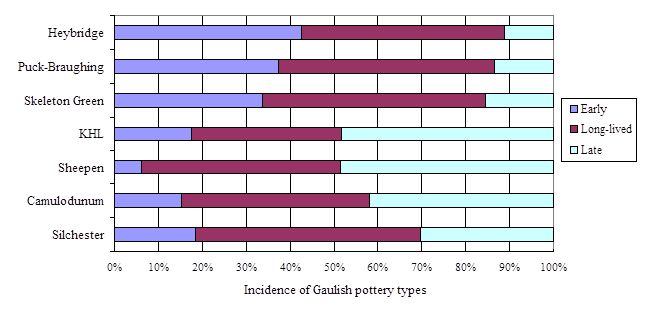
The compatibility between the pottery at Heybridge and in Hertfordshire is not restricted to early imports. The coarse pottery styles, too, have much in common, certainly in assemblages of 1st century BC date. This affinity was also noted with the pottery from the Airport Catering Site at Stansted (Going 2004), although the proximity of Stansted to Hertfordshire may have played a part here. Nevertheless, the stylistic links of the coarse pottery from Heybridge with that from sites like Puckeridge-Braughing, and indeed Stansted, are notable.
The study of deposition and zoning provides few detailed insights into the growth and decline of the settlement. The picture which emerges is one of overall homogeneity, with few distinctive trends in the pattern of pottery deposition. In the late Iron Age and early Roman period there appears to be high-density occupation, or at least pottery disposal, in the southern settlement zone, followed by a general inward movement towards the central zone through time. This reflects a gradually contracting settlement, which became more marked during the 3rd century. Distribution of late Iron Age pottery is evenly spread, with perhaps a bias towards the fringes of the settlement. By the later 4th century, most of the pottery was being deposited towards the western edge of the central zone. Perhaps due to a decreasing population, waste management seems to have changed towards the end of the Roman period, with fewer pits being dug. Increased levels of residuality during this time suggest pottery accumulating in surface collections, i.e. middens and dumps. This confirms the picture of a smaller, less structured, settlement with increasing amounts of surface rubbish.
Examination of the fully-quantified assemblage has allowed functional composition through time to be charted (Figure 758). While this serves to establish the range of forms current at any one time, such analysis is limited in revealing how vessels were actually used. Fortunately, the extensive pottery assemblage has provided information about day-to-day vessel use, and indicated, perhaps more indirectly, a diverse range of other functions of both a mundane and ritual nature.
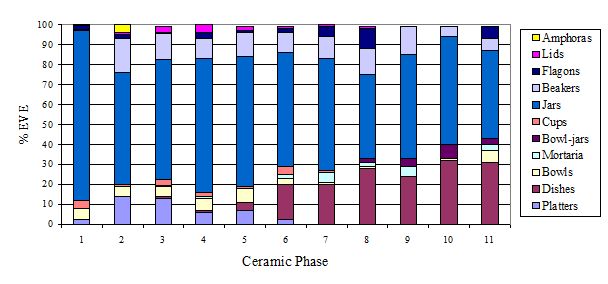
Overall, the pattern of composition is one of continuity, rather than change, though this is not to say that there were no differences through time. In subtle ways, the pottery from households of the late Iron Age, and the early, mid and late Roman periods should perhaps be expected to display different sets of forms and functions. Throughout the late Iron Age and Roman periods, jars dominated most assemblages, rarely falling below 50% measured by EVE. This is likely to reflect multiple purposes for the form, incorporating cooking, storage, and even table functions. In the earliest phase of late Iron Age occupation, jars enjoyed a dominant and, occasionally, exclusive presence. Besides their standard functions of storage and for cooking, jars served many other roles, indications of which could sometimes be ascertained from specific treatment of the pottery and from the context (see Vessel function and use). Clearly, however, jars declined in importance towards the end of the Roman period, while open forms (primarily dishes) gained in importance. It is possible that there was a change in eating habits or, more correctly, an acquiring of the functions previously assigned to jars.
In the late Iron Age, specific drinking and eating equipment was present, but perhaps not in every household; such forms were imported from the continent and their rarity was forced by restricted or controlled supply and prohibitive costs. But, reasonably quickly, the market opened up, increasing the supply of specialized dining vessels and promoting accessibility. The platter, in particular, was taken up by local potters, who produced approximate copies of the continental forms. Size differences between the imported and local platters suggest that their precise function was not being copied directly, but instead, devolved to incorporate native dining practices and food types. Despite continental influence, the inhabitants of Heybridge are unlikely to have taken their meals reclining on couches, although, for those living during the late Iron Age and earliest Roman periods, just the use of the new platters was perhaps enough to establish a cultural connection with the Romanized continent. The adoption of the platter for dining, though, implies a change in eating habits of some sort.
The pattern of functional composition (Figure 758), once established by the early 1st century AD, continued more-or-less unchanged until the late 4th century. Beakers remained the principal drinking vessel, while cups, and flagons at times, were relatively scarce. A limited number of Gallo-Belgic cups were imported during the late Iron Age, while most cups in the Roman period were samian. Little or no trace of the contents remains, but two samian cup forms, in particular, had remarkably consistent patterns of wear indicative of specific uses (see Vessel function and use). Use-wear analysis has provided direct evidence for vessel function, but brought with it salutary lessons. Function cannot be determined from shape alone, as two vessels of similar dimensions did not necessarily serve similar functions. At the same time, continuity of form is not always evidence for continuity of function.
Mortaria were introduced into Heybridge during the late 1st century BC, albeit in small numbers. The presence of an imported vessel in pyre-debris deposit 15416 (KPG5) suggests that these were prestige items in the late Iron Age, along with amphoras and platters. Use in late Iron Age funerary practice indicates the status of these vessels. At this time, the mortarium was exotic and rare and arrived at Heybridge singly, most likely alongside other imports from the continent. Usage of mortaria did not increase in step with other Roman forms, however. For most of the Roman period, mortaria formed only a minor component of assemblages (c. 2% by weight throughout). This is despite a slight rise in incidence during the second half of both 2nd and 3rd centuries due to the apparent production of mortaria in Area W (see Kilns). If the presence of mortaria is taken as an indicator of Romanization, then the general paucity of the form could be construed to reflect a lack of enthusiasm on the part of the inhabitants of Heybridge to take on 'Roman' food preparation habits. This is clearly a fallacy, since robust bowls could have easily served in a similar capacity (see Vessel function and use). The minor presence of mortaria is likely to reflect low levels of supply, rather than use. The peak visible during later 2nd century can be put into context of generally increased regional production during this time. K. Hartley (pers. comm.) suggests that new markets were available, for example on the Saxon Shore forts, invigorating supply. Other settlements received more mortaria as a consequence, and this may even have inspired the production of mortaria at Heybridge. High quantities of the form are anomalous, and low amounts of mortaria, if at all present, are usual in most assemblages. This is likely to mean that each household during the Roman period would have owned just a single mortarium or, indeed, none at all; its function being taken up by alternative forms.
Ritual must have played a large part in everyday life and the pottery analysis has provided several strands of evidence for this. Besides burial with the dead, and in structured deposits, which perhaps demonstrate the overt ritual use of pottery, examples which are more covert have also been identified (see Structured deposition). A case has been made for vessels bearing marks or symbols to be of ritual or superstitious significance, and similarly, the role of pots with applied moulded faces has been considered. The difficulty in identifying ritual activity from pottery evidence is acknowledged, but closer scrutiny of the way ceramics, and associated material, can be deposited yields positive results.
The consideration of vessel use at Heybridge is by no means exhaustive. Groups, types and assemblages with the most obvious potential were selected for study. However, this type of approach is the way forward in order to marry pottery assemblages with an understanding and interpretation with the places with which they are associated. Comparison at this level, between apparently similar or contrasting sites, and those which are contemporary or of a different date, is needed.
Internet Archaeology is an open access journal based in the Department of Archaeology, University of York. Except where otherwise noted, content from this work may be used under the terms of the Creative Commons Attribution 3.0 (CC BY) Unported licence, which permits unrestricted use, distribution, and reproduction in any medium, provided that attribution to the author(s), the title of the work, the Internet Archaeology journal and the relevant URL/DOI are given.
Terms and Conditions | Legal Statements | Privacy Policy | Cookies Policy | Citing Internet Archaeology
Internet Archaeology content is preserved for the long term with the Archaeology Data Service. Help sustain and support open access publication by donating to our Open Access Archaeology Fund.